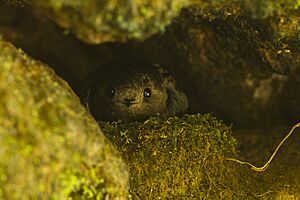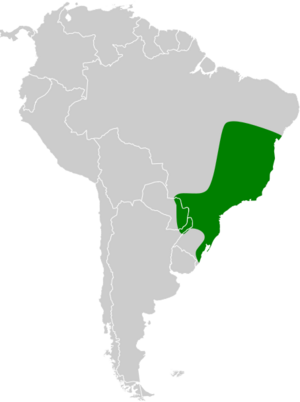Sooty swift facts for kids
Quick facts for kids Sooty swift |
|
|---|---|
 |
|
| Conservation status | |
| Scientific classification | |
| Genus: |
Cypseloides
|
| Species: |
fumigatus
|
 |
|
The sooty swift is a type of bird that belongs to the swift family. Its scientific name is Cypseloides fumigatus. You can find these birds in countries like Argentina, Brazil, and Paraguay.
Contents
About the Sooty Swift Family
The sooty swift is part of a group of very similar birds. This group includes the Rothschild's swift, white-chested swift, and American black swift. Sometimes, people thought the sooty swift and Rothschild's swift were the same species. However, the sooty swift is considered a single species with no different types or subspecies.
What the Sooty Swift Looks Like
The sooty swift is about 15 centimeters (6 inches) long. Males usually weigh around 42 grams (1.5 ounces), and females weigh about 41 grams (1.4 ounces). Both male and female sooty swifts look the same.
Their head is brown, with a dark patch around their eyes. Their forehead and cheeks are a lighter brown. The back of their body is a darker brown. Their tail is brown on top and a bit grayer underneath. Their wings are mostly blackish-brown on top and a little lighter underneath. Young sooty swifts look much like the adults, but they might have some gray edges on their body and wings.
Where Sooty Swifts Live
You can find the sooty swift in southeastern Brazil, from the southern part of Minas Gerais down to Rio Grande do Sul. They also live in eastern Paraguay and the Misiones Province of northern Argentina.
These birds are mostly seen flying over evergreen forests in mountains, tropical areas, and temperate zones. They also live in forests that are growing back, scrublands, and marshy areas. Sooty swifts are found at elevations between 700 and 2,100 meters (2,300 to 6,900 feet) above sea level.
Sooty Swift Behavior
Migration
The sooty swift seems to live in the same areas all year long. They do not travel long distances like some other birds.
Feeding
Like all swifts, the sooty swift catches and eats insects while flying. They are known as "aerial insectivores." However, scientists do not know many specific details about what they eat.
Reproduction
The sooty swift's breeding season happens at different times depending on where they live. Generally, it is between October and February.
They build their nests on rock faces. The nests are shaped like a cup or a crescent. They use materials like moss, ferns, leaves, small pebbles, and mud to build them. Most nests are on cliff ledges, but some are on the vertical rock face itself. Many nests are found very close to waterfalls, and some are even built behind the water! The female sooty swift lays only one egg. We do not know how long it takes for the egg to hatch or for the young bird to be ready to fly.
Calls and Sounds
The sounds the sooty swift makes while flying have been described in a few ways. They make a fast, rattling sound like "ti-i-i-i-a-a-a." They also make sounds like "tiju-tiju" and a soft "sip" or "sip-sip."
Sooty Swift Conservation Status
The International Union for Conservation of Nature (IUCN) has evaluated the sooty swift. They have listed it as a species of "Least Concern." This means that the bird is not currently in danger of disappearing. It lives in a large area, but its total population size is not known. Scientists believe the number of sooty swifts might be slowly decreasing. However, there are no immediate threats that have been identified for this bird.


